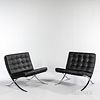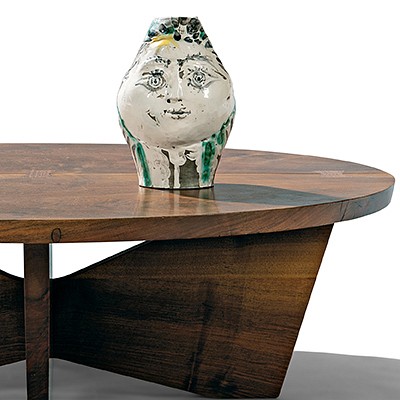Two Mies Van der Rohe (German, 1886-1969) for Knoll Barcelona Chairs
Lot 1234A
About Seller
Bonhams Skinner
274 Cedar Hill Street
Marlborough, MA 01752
United States
Founded over four decades ago, Bonhams Skinner offers more than 60 auctions annually. Bonhams Skinner auctions reach an international audience and showcase the unique, rare, and beautiful in dozens of categories, including the fine and decorative arts, jewelry, modern design, musical instruments, sc...Read more
About Auction
Catalog Only
By Bonhams Skinner
Jun 8, 2021 - Jun 16, 2021
Set Reminder
2021-06-08 12:00:00
2021-06-16 19:00:00
America/New_York
Bidsquare
Bidsquare : 20th Century Design
https://www.bidsquare.com/auctions/skinner/20th-century-design-7038
Our June sale offers over 500 lots for the discerning collector, dealer, or homeowner seeking furniture, artwork, and decorative objects spanning the 20th and early 21st centuries. Bonhams Skinner bidsquare@bonhamsskinner.com
Our June sale offers over 500 lots for the discerning collector, dealer, or homeowner seeking furniture, artwork, and decorative objects spanning the 20th and early 21st centuries. Bonhams Skinner bidsquare@bonhamsskinner.com
- Lot Description
Two Mies Van der Rohe (German, 1886-1969) for Knoll Barcelona Chairs, United States or Germany, c. 1965, tufted black leather with nine straps supporting the seat, eight supporting the back, forty individual panels of leather make up the seat and back, chromed steel frame with polished welds, unmarked, ht. 30 1/2, wd. 30, dp. 30 in.
Note: Regarded as one of the most important figures in the history of architecture, Ludwig Mies van der Rohe's "less-is-more" approach to design was the gold standard for many generations of modern architecture. His legendary career started humbly at his father's stonemasonry business, giving him an early appreciation of material and structure. From there he apprenticed with furniture designer Bruno Paul in Berlin before joining the office of Peter Behrens, an architect and painter at the forefront of the modern movement.
In 1912, Mies established his own office in Berlin. Through furniture, residential projects and extraordinary, yet unrealized concepts for skyscrapers, he gained recognition as a leader of the German modern movement. As such, he was selected to design the German Pavilion at the Barcelona Industrial Exposition of 1929. His design, a rhythmic arrangement of horizontal and vertical planes of glass, stone and metal was an experiment in free flowing space. With no discernible distinction between rooms or inside and outside, the design fundamentally challenged the architectural 'boxes within a box' standard of the time. Inside, Mies included the Barcelona Chair and Ottoman, designed to offer the King and Queen of Spain to a place to rest (they in fact never sat down). The Barcelona Pavilion and the chairs it contained are universally recognized as milestones of modern design.
Mies served as Vice President of the Deutsher Werkbund and Director of the Bauhaus from 1930 until it closed in 1933. He immigrated to the United States in 1938 to become the director of architecture at the Armour Institute (later the Illinois Institute of Technology). From his Chicago-based practice, Mies designed a portfolio of buildings that changed the face of American institutional architecture - the most notable examples being the IIT campus and the Seagram Building in New York. While at IIT he befriended and mentored a young Florence Knoll. Florence has always credited Mies as her most influential instructor, and, in 1948, Mies granted Knoll exclusive rights to produce his furniture, including the Barcelona collection, the Brno chair, and MR series. - KnollCondition
Any condition statement is given as a courtesy to a client, is only an opinion and should not be treated as a statement of fact. Skinner Inc. shall have no responsibility for any error or omission. The absence of a condition statement does not imply that the lot is in perfect condition or completely free from wear and tear, imperfections or the effects of aging. - Shipping Info
-
Please visit http://www.skinnerinc.com/services/payment-and-shipping/ for information regarding the collection of items purchased at auction.
-
- Buyer's Premium



 EUR
EUR CAD
CAD AUD
AUD GBP
GBP MXN
MXN HKD
HKD CNY
CNY MYR
MYR SEK
SEK SGD
SGD CHF
CHF THB
THB



